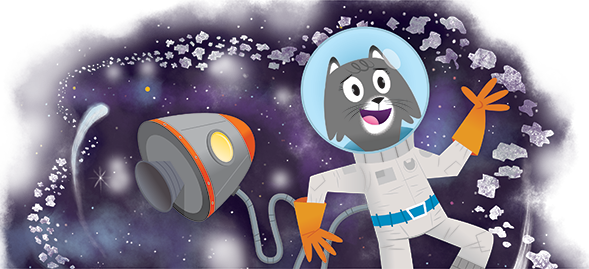Dear Rhemi,
Astronauts eat all kinds of different foods up in space. The food is often similar to what we have here on Earth. But in space, there’s very little gravity. There’s very limited refrigeration, too. On the International Space Station, the refrigerator is only about half the size of a microwave. That means scientists who prepare and package astronaut food have to do it in ways that take up very little room and don’t need to be kept cold.
The first foods
In 1962, John Glenn became the first U.S. astronaut to orbit the Earth and also the first American to eat food there. He ate applesauce from a tube. In the early days of space exploration, a lot of astronauts ate food that was in little cubes or squeezed out of tubes. It helped keep the food from drifting around or floating away.
When I got your question, I decided to visit my friend Norman Lewis, a plant scientist at Washington State University. He showed me a package of cosmonaut food some colleagues in Russia gave him from a mission many years ago. Inside was dried fruit, canned meat, and a meal in an aluminum toothpaste tube.
Astronaut food has come a long way since. NASA has prepared menus that include dried fruit, yogurt, sausage, beef jerky, mashed potatoes, mac and cheese, and shrimp cocktail. Even desserts. The meals are often dehydrated. The astronauts just add water.
Astronaut farmers
Scientists and astronauts are also curious about growing fresh food in space. Project Veggie on the International Space Station has helped astronauts become farmers and grow their own lettuce and cabbage.
My friend Norm is also helping NASA learn more about how plants grow and develop in space, particularly how the microgravity environment affects a plant’s overall life processes.
A plant growth chamber, about the size of a mini-fridge, was sent up to the space station in two stages, the most recent stage going up in a pod last month. A big robotic arm, the Canadarm, reached out and grabbed the pod to bring it into the station. Researchers will now work with astronauts on the station to research and discover how the plants grow and how they are affected by microgravity.
Looking to the future
The more we know about how plants work, the better we can figure out how to grow them in in space. That could mean places like the moon or Mars, Lewis said. For now, astronauts depend on teams back on Earth to restock their supplies. But if astronauts could grow enough of their own food, they could go on even longer trips into space.
Who knows, maybe instead of only eating applesauce out of a tube, astronauts will have a small tree of fresh, delicious apples. Until then, if I ever get the chance to go to space, I definitely think I’d like to take along some tuna salad. What kind of food would you most want to take on an expedition to space? Tell me about it sometime at Dr.Universe@wsu.edu.
Sincerely,
Dr. Universe
Correction: An earlier version stated that in 1962, when astronaut John Glenn became the first person to orbit the Earth, he also became the first American to eat food there.
Updated: In 1962, John Glenn became the first U.S. astronaut to orbit the Earth and also the first American to eat food there.
ABOUT ASK DR. UNIVERSE
- Ask Dr. Universe connects K-8 students with researchers at Washington State University through Q&A. Students can submit science questions on the ASK page.
- Are you a teacher, parent, or curious grown-up? Follow along on Twitter or Facebook.
- Do you want to reprint this Q&A? Just send a message to Dr.Universe@wsu.edu
